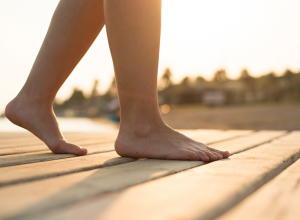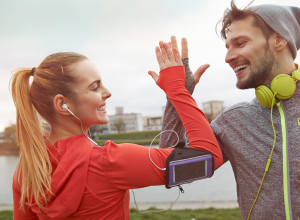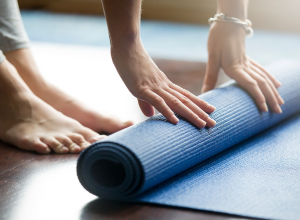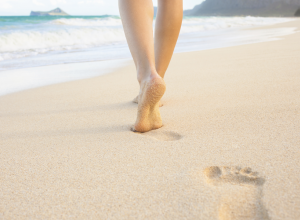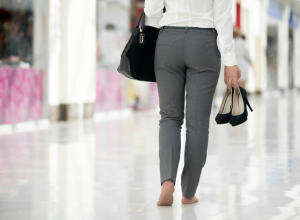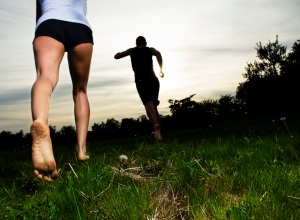
Barefoot Running
Barefoot running, also called natural running, is the practice of running or jogging without wearing footwear. It has become a popular trend in recent years, with many proponents arguing that running without shoes is healthier than running in traditional footwear like sneakers.
Why Is Barefoot Running Considered Healthy?
Human beings in many cultures run barefoot, but Americans have traditionally worn athletic shoes, at least in recent history. However, many health and sports professionals are now blaming traditional running and jogging shoes for chronic foot and leg injuries, especially repetitive stress injuries. The argument? Athletic shoes interfere with a person’s natural gait, meaning the foot and heel strike the pad in a running shoe slightly differently than they would on the bare ground. And those slight differences can make a huge impact on your feet, legs, back and overall performance.
Scientists have studied the differences between foot and leg movement in people who typically run barefoot versus those who are usually shoe shod while running. And they’ve found that shoes can actually have a pretty detrimental effect on your feet, ankles and other body parts. The reason is because shoes create a situation in which you’re not walking, running and jumping properly or how you would without the support of shoes. Your muscles, ligaments, bones and joints function in an unnatural way, increasing the chance of injuries. And wearing shoes is actually said to create weak muscles, as your foot becomes reliant on its comfy shoe home for strength and support. In essence, the very things that are supposed to protect and cushion your feet could actually be creating more harm than good.
What Are the Benefits of Barefoot Running?
In addition to returning you to your natural pronation, stride and gait, barefoot running and running in nearly barefoot shoes like Vibram’s FiveFingers significantly strengthens your feet — muscles, joints, ligaments and all. What’s more, habitually running barefoot can actually help improve a runner’s performance. This is due in part to a better, more natural running style and strengthened foot, but also to less “weighing you down.” Furthermore, barefoot running changes the way you run (with your midfoot and forefoot striking the ground first rather than your heel striking the ground first), which, according to experts like Born to Run author Chris McDougall, can actually decrease your chances of developing common foot and leg problems like plantar fasciitis and heel pain.
READ ALSO: The Truth About The Barefoot Walking Trend — Are Bare Feet Better?
What Are the Dangers of Barefoot Running?
One of the biggest worries people have before setting off on the path to being barefoot is that they’ll suffer injuries from pebbles, broken glass, twigs and other sharp objects. This is a possibility, so most barefoot runners stick to surfaces that don’t usually have these risks. Examples include running tracks, grassy fields, beaches and barefoot paths.
The most serious risk associated with barefoot running is starting too quickly. If you wear a neck brace for a month, your muscles will be weak when you remove it. The same goes for athletic shoes. Your feet are weak and reliant on the shoes for cushioning and support. Therefore, it’s strongly advised that anyone who’d like to try barefoot running start very slowly.
How Should I Start Running Barefoot?
One of the most important things to remember when barefoot running is to start slow. Rather than chucking your shoes and running a marathon, start out by walking barefoot for 10 to 15 minutes each day. As your feet become stronger and used to functioning without shoes, you can slowly add more time to your walks. After a couple of weeks, try some light barefoot jogging. Listen to your body and the soles of your feet and only increase to full on running when things feel comfortable. The human foot and lower leg are made to absorb shock, and they do a very sufficient job of doing so. But it’s extremely important that you work your way back to natural running after years of wearing shoes.
What Is the Difference Between Barefoot Running and Minimalist Running?
There’s a bit of a gray area in the running world called minimalist running. It’s essentially running with a shoe that does its best to mimic being barefoot. While many people prefer this type of running over being completely barefoot (because of the shoe’s protection against stones, glass and other potentially hazardous “roadblocks”), biomechanics studies have shown that minimalist running shoes don’t offer the same benefits as being completely barefoot.
Notice concerning medical entries:
Articles having medical content shall serve exclusively for the purpose of general information. Such articles are not suitable for any (self-) diagnosis and treatment of individual illnesses and medical indications. In particular, they cannot substitute for the examination, advice, or treatment by a licensed physician or pharmacist. No replies to any individual questions shall be effected through the articles.

